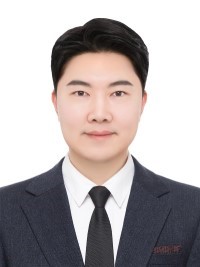Prof. Gi-won Lee Develops a Wearable Triboelectric Nanogenerator
- admin
- 2024-09-13
- 235
· Professor Gi-won Lee (Department of Chemical Engineering) Develops a Wearable Triboelectric Nanogenerator
Inspired by the Surface of Rice Leaves
- Develops a high-efficiency triboelectric nanogenerator using the surface
characteristics of rice leaves and the microstructure of a nonflammable
elastomer -
- Can be used as an artificial leaf that generates electricity from water
and wind, and as a wearable wristband that produces electricity from human
movement -
- Published in the world-renowned journal Advanced Functional Materials by Wiley
(IF: 18.5, top 3.7% in the field)
Professor
Gi-Won Lee (Department of Chemical Engineering), in collaboration with
Professor Gil-Won Cho of POSTECH and Professor Seung-Goo Lee of Ulsan
University, successfully developed a wearable triboelectric nanogenerator
inspired by the surface of rice leaves. This research was published as a Front Cover
paper in an internationally renowned journal in the field of materials science.

Professor Gi-Won Lee from the
Department of Chemical Engineering
The paper, titled ‘Anisotropic Fluorinated-Elastomer-Blended
Micro-Dominoes for Wearable Triboelectric Nanogenerator,’ was published on
August 8, 2024, in the SCI international journal Advanced Functional Materials
(JCR top 3.7% in materials engineering, IF 18.5).
Triboelectric
nanogenerators (TENGs), which convert mechanical energy into electrical energy
by using a charging phenomenon generated when two different objects come into
contact, have been the focus of active research in recent years. The small and
flexible TENG is gaining attention as a next-generation portable power source
in fields such as electronic skin, the Internet of Things (IoT), healthcare,
and environmental monitoring. However, to apply these nanogenerators in
everyday life, various issues such as energy conversion efficiency,
stretchability and deformability, operational stability, and ease of
manufacturing must be addressed.
Recently, to
address these challenges, a research team led by Professor Gi-Won Lee from
Kwangwoon University’s Department of Chemical Engineering, Professor Gil-Won
Cho from POSTECH’s Department of Chemical Engineering, and Professor Seung-Goo
Lee from Ulsan University’s Department of Nanoenergy Chemistry developed a
high-efficiency triboelectric nanogenerator using a micro-domino structure made
of fluorinated elastomers.
Inspired by
dominoes that fall sequentially with a small force, the research team applied
the micro-domino structure to the device, and found that the micro-dominoes
easily deformed on the surface of the contact object and make broad contact,
generating friction electricity with a high efficiency of 1,290 V output
voltage and 9.8 W/m2 power density when a person moves (frequency 5
Hz).
Furthermore,
the team used fluorinated elastomers as the material for the nanogenerator,
which not only generates electrical energy through contact with water, but also
stays clean at all times, making it last longer.
In particular,
like water droplets on the surface of a leaf, water droplets dropped on the
domino structure of the nanogenerator roll easily in one direction, so it was
possible to harvest electricity from a single droplet and achieve high energy
conversion efficiency.
Based on these
device properties, the team showed that the device could be utilized as an
artificial leaf that effectively generates electricity from wind or raindrops,
and demonstrated a wearable nanogenerator band that can generate electricity
with the touch of a wrist, shaking, or washing hands.
Professor
Gi-Won Lee stated, "The nanogenerator developed in this study can generate
electricity with high efficiency from water and wind, making it a potential
alternative to solar cells in regions with frequent rain and wind. It is also
expected to be used as a portable power source for many future wearable devices,
eliminating the need for charging."
The findings
were recently published as a Front Cover article in the world-renowned journal
Advanced Functional Materials, and the research was supported by the following
projects.
Https://doi.org/10.1002/adfm.202470177
- National
Research Foundation of Korea: Ministry of Science and ICT, Ministry of
Education
- Kwangwoon
University Internal Research Project

Figure 1. Schematic and application examples of
wearable nanogenerators with micro-domino structures

Figure 2. Paper published as a Front Cover in the prestigious materials science journal, Advanced Functional Materials